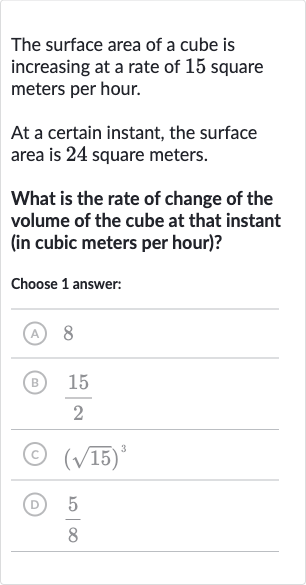AI tutor
Welcome to Bytelearn!
Let’s check out your problem:

The surface area of a cube is increasing at a rate of square meters per hour.At a certain instant, the surface area is square meters.What is the rate of change of the volume of the cube at that instant (in cubic meters per hour)?Choose answer:(A) (B) (C) (D)
Full solution
Q. The surface area of a cube is increasing at a rate of square meters per hour.At a certain instant, the surface area is square meters.What is the rate of change of the volume of the cube at that instant (in cubic meters per hour)?Choose answer:(A) (B) (C) (D)
- Surface Area Calculation: The surface area of a cube is times one of its side's square, so one side's square is .Calculate the length of one side.Side length = .
- Volume Calculation: The volume of a cube is side length cubed, . Calculate the volume with the side length. Volume = .
- Surface Area Rate of Change: The surface area is increasing at a rate of . Since the surface area is , .
- Side Length Rate of Change: Solve for ...
- Volume Rate of Change: The rate of change of the volume is given by . Calculate using the side length and .
More problems from Volume of cubes and rectangular prisms: word problems
QuestionGet tutor help
QuestionGet tutor help
QuestionGet tutor help
QuestionGet tutor help
QuestionGet tutor help
QuestionGet tutor help
QuestionGet tutor help
QuestionGet tutor help
QuestionGet tutor help
QuestionGet tutor help
